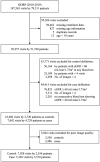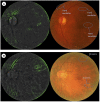Deep learning algorithms to detect diabetic kidney disease from retinal photographs in multiethnic populations with diabetes
- PMID: 37659103
- PMCID: PMC10654858
- DOI: 10.1093/jamia/ocad179
Deep learning algorithms to detect diabetic kidney disease from retinal photographs in multiethnic populations with diabetes
Erratum in
-
Correction to: Deep learning algorithms to detect diabetic kidney disease from retinal photographs in multiethnic populations with diabetes.J Am Med Inform Assoc. 2024 Apr 3;31(4):1047. doi: 10.1093/jamia/ocae012. J Am Med Inform Assoc. 2024. PMID: 38269584 Free PMC article. No abstract available.
Abstract
Objective: To develop a deep learning algorithm (DLA) to detect diabetic kideny disease (DKD) from retinal photographs of patients with diabetes, and evaluate performance in multiethnic populations.
Materials and methods: We trained 3 models: (1) image-only; (2) risk factor (RF)-only multivariable logistic regression (LR) model adjusted for age, sex, ethnicity, diabetes duration, HbA1c, systolic blood pressure; (3) hybrid multivariable LR model combining RF data and standardized z-scores from image-only model. Data from Singapore Integrated Diabetic Retinopathy Program (SiDRP) were used to develop (6066 participants with diabetes, primary-care-based) and internally validate (5-fold cross-validation) the models. External testing on 2 independent datasets: (1) Singapore Epidemiology of Eye Diseases (SEED) study (1885 participants with diabetes, population-based); (2) Singapore Macroangiopathy and Microvascular Reactivity in Type 2 Diabetes (SMART2D) (439 participants with diabetes, cross-sectional) in Singapore. Supplementary external testing on 2 Caucasian cohorts: (3) Australian Eye and Heart Study (AHES) (460 participants with diabetes, cross-sectional) and (4) Northern Ireland Cohort for the Longitudinal Study of Ageing (NICOLA) (265 participants with diabetes, cross-sectional).
Results: In SiDRP validation, area under the curve (AUC) was 0.826(95% CI 0.818-0.833) for image-only, 0.847(0.840-0.854) for RF-only, and 0.866(0.859-0.872) for hybrid. Estimates with SEED were 0.764(0.743-0.785) for image-only, 0.802(0.783-0.822) for RF-only, and 0.828(0.810-0.846) for hybrid. In SMART2D, AUC was 0.726(0.686-0.765) for image-only, 0.701(0.660-0.741) in RF-only, 0.761(0.724-0.797) for hybrid.
Discussion and conclusion: There is potential for DLA using retinal images as a screening adjunct for DKD among individuals with diabetes. This can value-add to existing DLA systems which diagnose diabetic retinopathy from retinal images, facilitating primary screening for DKD.
Keywords: artificial intelligence; diabetes; machine learning; renal insufficiency; retina; screening.
© The Author(s) 2023. Published by Oxford University Press on behalf of the American Medical Informatics Association.
Conflict of interest statement
H.H. is a co-founder of start-up company EyRIS. G.L. has consulted for Bayer and Novartis and has received travel grants and research funding from Bayer. A.Y.L. reports grants from Santen, personal fees from Genentech, personal fees from US FDA, personal fees from Johnson and Johnson, grants from Carl Zeiss Meditec, personal fees from Topcon, personal fees from Gyroscope, non‐financial support from Microsoft, grants from Regeneron, outside the submitted work. T.Y.W. is a consultant for Aldropika Therapeutics, Bayer, Boehringer-Ingelheim, Genentech, Iveric Bio, Novartis, Oxurion, Plano, Roche, Sanofi, Shanghai Henlius. He is an inventor, holds patents, and is a co-founder of start-up companies EyRiS and Visre, which have interests in, and develop digital solutions for eye diseases. G.S.W.T. reported receiving travel support from Carl Zeiss Pte Ltd; receiving personal fees and consultancy fees from Novartis; receiving grants from Bayer AG and Santen Pharmaceutical Company, Ltd; and receiving travel support from Alcon outside the submitted work. The rest of the authors declare no conflicts of interest.
Figures




References
-
- Levin A, Stevens PE, Bilous RW, et al.Kidney Disease: Improving Global Outcomes (KDIGO) CKD Work Group. KDIGO 2012 clinical practice guideline for the evaluation and management of chronic kidney disease. Kidney Int Suppl. 2013;3(1):1-150.
-
- American Diabetes Association. 11. Microvascular complications and foot care: standards of medical care in diabetes—2019. Diabetes Care 2019;42(Suppl_1):S124-S38. - PubMed
Publication types
MeSH terms
Grants and funding
LinkOut - more resources
Full Text Sources
Other Literature Sources
Medical

